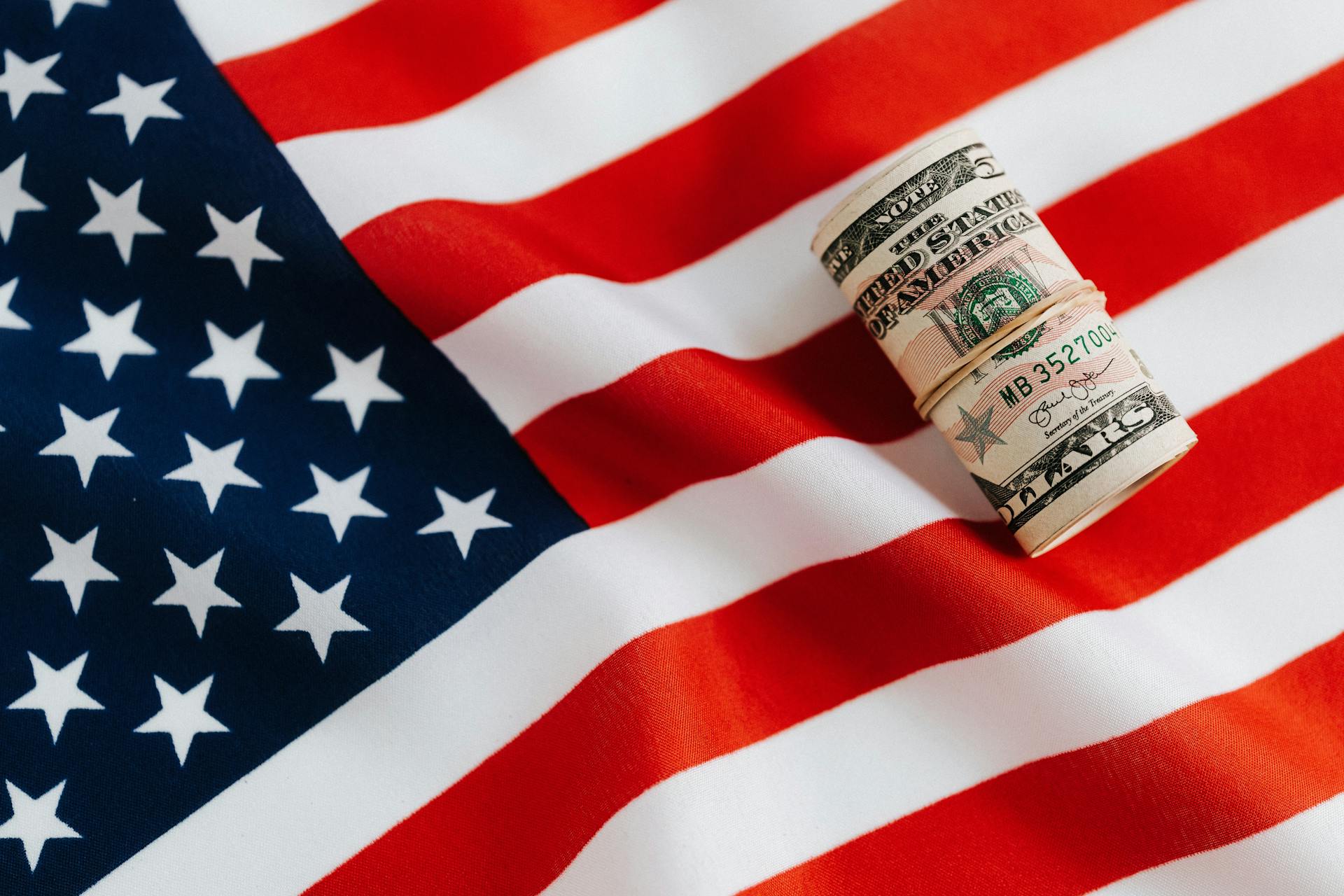
Carry is a key concept in investment, referring to the excess return earned by an investment above its risk-free rate. In other words, it's the extra profit you get from investing in a security that's expected to outperform a risk-free asset like a government bond.
Carry can be generated from various sources, including interest rate differentials, currency fluctuations, and credit spreads. For example, if you lend money in a country with a high interest rate, you'll earn a higher return than if you lent the same amount in a country with a low interest rate.
The carry trade is a popular investment strategy that involves borrowing in a low-interest-rate currency and investing in a high-interest-rate currency. This strategy can be profitable, but it also comes with significant risks, including currency fluctuations and credit risk.
For more insights, see: Value Investing Strategy
What is Carried Interest?
Carried interest is a performance fee paid to the General Partner (GP) and managers of a private equity or venture capital fund.

This fee is only paid once the fund has returned the investors' capital and surpassed a minimum hurdle rate of return.
The hurdle rate is detailed in the fund's investor agreement, along with the distribution waterfall that outlines how proceeds of asset sales are divided between the Limited Partners (LPs) and the GP.
The waterfall schedule ensures that all proceeds from the fund's assets are directed either to the LPs or the GP in a manner that satisfies the investment agreement.
Measures of fund valuation and performance, such as IRRs or MOICs, are published net of carried interest.
See what others are reading: Scion S Capital Meaning Michael Burry
Carried Interest Structures
Carried interest structures vary significantly, influencing the dynamics between general partners (GPs) and investors.
Deal-by-deal carried interest is applied on a per-investment basis, allowing GPs to claim their profit share from each successful investment individually, possibly after achieving a preferred return. This setup can result in higher rewards for GPs but increased risk for investors.
Explore further: Carried Interest

In a deal-by-deal carry structure, GPs can claim a large share of profits from a single successful investment, even if other investments fail. For example, if a venture capital fund invests in five startups and one returns 10 million euros on a 2 million euros investment, the GP would immediately claim 20% of the profit, or 1.6 million euros, from this successful exit.
Fund investment carried interest, on the other hand, is calculated based on the fund's aggregate performance, encouraging a focus on long-term success. Only after all initial capital and a preferred return have been distributed to limited partners (LPs) does the GP receive their share of any remaining profits.
In a fund investment carry structure, the GP would not benefit from any carried distribution if the fund's total investment and revenue are equal, with no remaining profits to distribute. For example, if a venture capital fund invests 10 million euros and generates only 10 million euros in revenue, the GP would not receive any carried interest.
Related reading: Investment Loss Carry Forward
Understanding Trades
Carry trades involve borrowing in a low-interest-rate currency, known as the funding currency, to invest in high-yielding assets denominated in another currency, the target currency.
This strategy aims to profit from the interest rate differential and potential appreciation of the target currency. For example, an investor might borrow Japanese yen at a 0.1% interest rate to buy U.S. Treasury bonds yielding 4%.
Historically, popular carry trade pairs have included borrowing in Japanese yen or Swiss francs to invest in higher-interest currencies, such as the U.S. dollar, Mexican peso, or Australian dollar.
Additional reading: Vanguard Target Date Funds Lawsuit
Understanding Trades
Carry trades are a type of investment strategy that involves borrowing money in a low-interest-rate currency to invest in high-yielding assets denominated in another currency.
The goal of a carry trade is to profit from the interest rate differential between the two currencies, as well as any potential appreciation of the target currency.
Historically, popular carry trade pairs have included borrowing in Japanese yen or Swiss francs to invest in higher-interest currencies like the U.S. dollar, Mexican peso, or Australian dollar.
Related reading: What Is Carry in Basketball?

Large institutional investors, hedge funds, and forex traders commonly engage in carry trades, as they have the resources to manage the associated risks.
Carry trades can be complex and involve significant risks, including exchange rate fluctuations and interest rate changes.
Individual investors can also engage in carry trades, but it's essential to have a solid understanding of the risks and rewards involved.
Carry trades are not limited to currencies; they can also be applied to other assets, such as commodities or stocks.
In a carry trade, the investor borrows money in a low-interest-rate currency and uses it to invest in a high-yielding asset, with the goal of profiting from the interest rate differential and any potential appreciation of the asset.
For example, an investor might borrow Japanese yen at a 0.1% interest rate to buy U.S. Treasury bonds yielding 4%, profiting from the 3.9% difference if exchange rates stay about the same.
Carry trades are often used by large institutional investors, hedge funds, and forex traders who can manage the associated risks.
The specific currencies involved in a carry trade depend on global economic conditions and monetary policies.
You might enjoy: Negative Carry

Carry trades can be a lucrative strategy, but they require a deep understanding of the markets and the ability to manage risk.
It's essential to have a solid understanding of the risks and rewards involved in carry trades, as they can be complex and volatile.
Carry trades are not suitable for all investors, and it's crucial to assess your risk tolerance and investment goals before engaging in this type of trading.
In a carry trade, the investor is essentially betting on the difference in interest rates between the two currencies, as well as any potential appreciation of the target currency.
Carry trades can be used to generate returns in a low-yield environment, but they require a high degree of skill and expertise.
Carry trades are often used by professional traders and investors who have a deep understanding of the markets and the ability to manage risk.
The key to successful carry trades is to have a solid understanding of the markets and the ability to manage risk.
Carry trades can be a powerful tool for generating returns, but they require a high degree of skill and expertise.
A different take: Deep Value Investing
Trade Risks

Carry trades are not without risks, and investors must be aware of the potential pitfalls. The currency carry trade, for instance, can lead to rapid currency value collapse and appreciation.
One major risk is that foreign exchange rates may change in such a way that the investor would have to pay back more expensive currency with less valuable currency. This can happen when the borrowed currency appreciates against the currency used to repay the debt.
The 2008-2011 Icelandic financial crisis is a prime example of the risks associated with carry trades. The undisciplined use of the carry trade led to a dramatic depreciation of the Icelandic currency, making loan payments unaffordable and resulting in widespread defaults.
The US dollar and Japanese yen have been the most heavily used currencies in carry trade transactions since the 1990s, but larger economies like Japan have more immunity to the disruptive aspects of the carry trade due to the sheer quantity of their existing currency.
Recommended read: Trade Idea

Geopolitical risks, such as political instability, trade tensions, or changes in government policies, can also impact the success of carry trades. Investors must stay informed about geopolitical developments to mitigate these risks.
The unwinding of carry trades can create a self-reinforcing cycle, where more investors unwind, driving up demand for the Japanese currency, making existing carry trades less profitable, and prompting more investors to head for the exits.
What Influences Trade Decisions?
Trade decisions can be heavily influenced by psychological factors, which can sometimes lead to poor outcomes.
Overconfidence is a common bias that can cause traders to underestimate risks, such as currency fluctuations or interest rate changes.
The fear of missing out (FOMO) can drive traders to enter positions without conducting thorough analysis, resulting in significant losses.
Traders often fail to account for the risks of currency fluctuations, which can have a substantial impact on trade decisions.
A different take: Capital Budgeting Decisions Include
Key Concepts
Carry (investment) is a strategy that involves borrowing at a low interest rate and reinvesting in a currency or financial product with a higher rate of return. This can be a lucrative way to generate profits, but it's not without its risks.

Carried interest is a performance fee for the general partner (GP) in a private equity fund, and it's a key concept to understand in this context. It's a percentage of the profits that the GP earns after the investors have received their return of capital and a minimum hurdle rate of return.
A carry trade is a type of investment strategy that involves borrowing at a low interest rate and reinvesting in a currency or financial product with a higher rate of return. This can be a high-risk, high-reward approach to investing.
Here are some key facts about carry trades:
- A carry trade is a strategy that involves borrowing at a low interest rate and reinvesting in a currency or financial product with a higher rate of return.
- Carry trades are only for experienced investors due to the risks involved.
- Researchers have found that shifts in the carry trade markets are always fast, with no slow changeover of carry trade regimes.
Carried interest in private equity and venture capital funds is a performance fee that compensates the GP and managers with a percentage of the profits on the fund's investments. This performance fee provides an incentive to maximise the fund's profits for the investors and is only paid once the fund has returned the investors' capital and surpassed a minimum hurdle rate of return.
Research and Analysis

Carry investment is a popular strategy among investors, and research has shown that it can be an effective way to generate returns.
A study found that carry investors tend to focus on assets with high potential for returns, such as private equity and hedge funds.
Investors who use the carry strategy often look for assets with high cash flows, which can help them generate consistent returns.
By focusing on assets with high cash flows, carry investors can potentially earn higher returns than other types of investors.
The carry strategy can be particularly effective in times of economic growth, when asset prices tend to rise.
You might enjoy: Copilot Money Future Cash Flows
Do Central Banks Play a Role?
Central banks do play a significant role in the dynamics of carry trades. Changes in interest rates can alter the attractiveness of certain currencies for carry trading.
The 2024 Japanese yen unwinding after the BOJ's moves is a clear example of this. Central banks can influence currency values and trading patterns.
Interest rates can make or break a currency's appeal to carry traders. The Bank of Japan's (BOJ) moves had a notable impact on the Japanese yen's value.
Explore further: 2008 Société Générale Trading Loss
What Research Says About Profits

Research has shown that the majority of businesses, a staggering 64%, rely on profits to drive their growth and innovation.
The average profit margin for small businesses is around 10%, significantly lower than larger corporations which average around 18%.
Having a clear understanding of profit margins is crucial for making informed business decisions, as it can indicate whether a company is operating efficiently or not.
A study found that companies with higher profit margins tend to outperform their competitors, with a 25% higher return on investment.
Businesses that focus on long-term profitability often experience greater success, with 75% of companies that prioritize profitability reporting higher sales and revenue.
Expand your knowledge: Ibkr Stock Profit Margin
History of Strategies
The history of research and analysis is a long and varied one. From the early days of scientific inquiry to the present, researchers have employed a range of strategies to gather and analyze data.
One of the earliest recorded methods of research was the use of observation, as seen in the work of ancient Greek philosophers such as Aristotle. He spent years studying the natural world and documenting his findings.
Worth a look: Cambridge Investment Research

The scientific method, which involves formulating a hypothesis, testing it through experimentation, and drawing conclusions based on the results, was first developed in the 17th century by scientists such as Francis Bacon. This approach remains a cornerstone of research today.
In the 20th century, researchers began to use more systematic and quantitative methods, such as statistical analysis and survey research. These methods allowed for more precise and reliable data collection and analysis.
Today, researchers continue to develop and refine their strategies, incorporating new technologies and techniques such as data mining and machine learning.
Recommended read: Alternative Data (finance)
Frequently Asked Questions
Is carry trade still profitable?
Carry trades can still be profitable, but only when interest rate differences between currencies are significant, such as the 5-6% annual returns seen in US-Japan dollar-yen trades. However, market conditions can change quickly, making it essential to stay informed.
Featured Images: pexels.com

